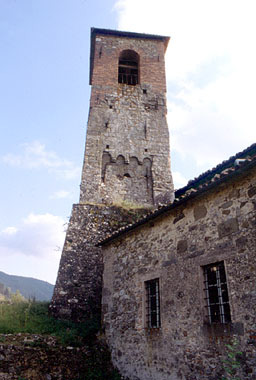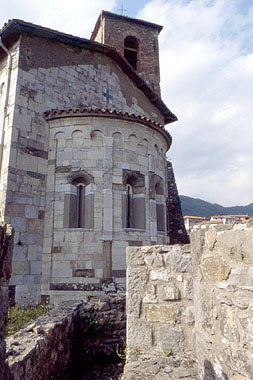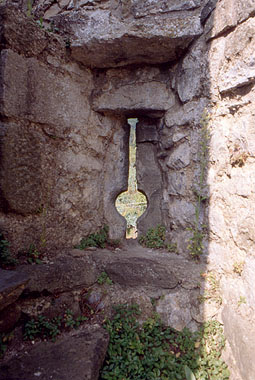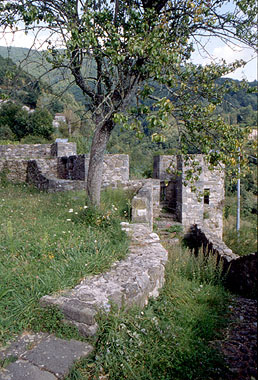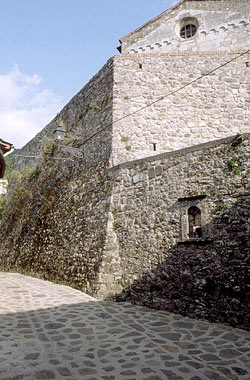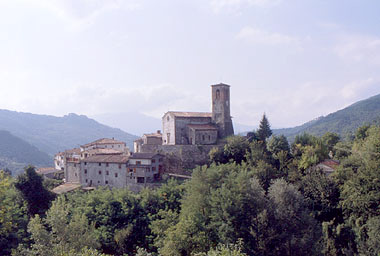Rocca of Ceserana

Information
Foundation:
XIIth century
District/Location:
Fosciandora, locality Ceserana
District:
Garfagnana

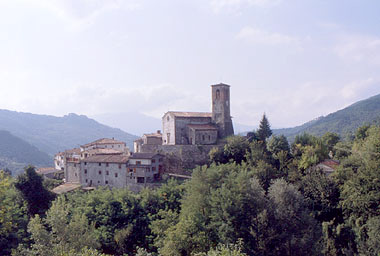
On a terraced hill to the left of the river Serchio, at about 400 m. a.s.l., the rocca of Ceserana faces the nearby village of Lupinaia along the ancient frontier between the territory of Lucca and that of the Dukes of Este.
The unassuming walls of local stone, fruit of a considerable XVth century adaptation, incorporate some parts of the pre-existing thinner medieval structures that have been in part brought to light thanks to recent restorations.
The circle of walls with its narrow loopholes where light firearms were placed was nearly entirely lined by a patrol balcony closed between two massive towers strategically positioned at the entrance of the rocca and facing the hills above the village.
Within the defensive perimeter the Romanesque church of S. Andrea has white stone walls and is adorned by small arches upon capitals with carved floral and anthropomorphic designs. Its bell tower rests upon the base of a defence tower showing the close connection between the religious building and the extant fortified structures.
The unassuming walls of local stone, fruit of a considerable XVth century adaptation, incorporate some parts of the pre-existing thinner medieval structures that have been in part brought to light thanks to recent restorations.
The circle of walls with its narrow loopholes where light firearms were placed was nearly entirely lined by a patrol balcony closed between two massive towers strategically positioned at the entrance of the rocca and facing the hills above the village.
Within the defensive perimeter the Romanesque church of S. Andrea has white stone walls and is adorned by small arches upon capitals with carved floral and anthropomorphic designs. Its bell tower rests upon the base of a defence tower showing the close connection between the religious building and the extant fortified structures.
Piazza Sant'Andrea, 4, 55020 Ceserana LU
The garrison was dismantled in the XIXth century and the grounds within the walls were turned into gardens causing a gradual deterioration of the fortifications. The rocca was bought by the Town Council of Fosciandora and recently reinforced and repaired reaffirming the value of this small but significant monumental complex in the Serchio valley.
Occupied by Lucca in 1170, during the wars against the confederations of families in Garfagnana, the rocca of Ceserana assumed the role of main garrison in the 'Vicaria delle Terre Nuove' among other military garrisons controlling this recently conquered territory. The place played an important role during the wars of the XIIIth and XIVth centuries and in 1401 was listed by Paolo Guinigi among the outposts that needed to be properly fortified.
With the inclusion of Ceserana in the territory of the Dukes of Este, grand fortification works on the rocca began and lasted from 1467 to 1474. Successively it became the nest of bandits and was left to decay. The conditions of the fortifications must have been appalling on the eve of the war between Modena and Lucca, in 1614, if we trust the description made by the keeper Orazio Caselli.
The Duke of Este entrusted the architect Pasio Pasi with the reinforcement of the rocca; his intervention was more necessary than ever since Lucca had built, in the neighbouring village of Lupinaia, a tower that with its height directly menaced from above the village of Ceserana. Pasi's project was interrupted with the end of the war and only partially achieved in one of the two massive semicircular towers equipped with gunports.
With the inclusion of Ceserana in the territory of the Dukes of Este, grand fortification works on the rocca began and lasted from 1467 to 1474. Successively it became the nest of bandits and was left to decay. The conditions of the fortifications must have been appalling on the eve of the war between Modena and Lucca, in 1614, if we trust the description made by the keeper Orazio Caselli.
The Duke of Este entrusted the architect Pasio Pasi with the reinforcement of the rocca; his intervention was more necessary than ever since Lucca had built, in the neighbouring village of Lupinaia, a tower that with its height directly menaced from above the village of Ceserana. Pasi's project was interrupted with the end of the war and only partially achieved in one of the two massive semicircular towers equipped with gunports.
Scopri altre attrazioni vicino a Rocca of Ceserana
See allYou may also like..
See allFind more
0








